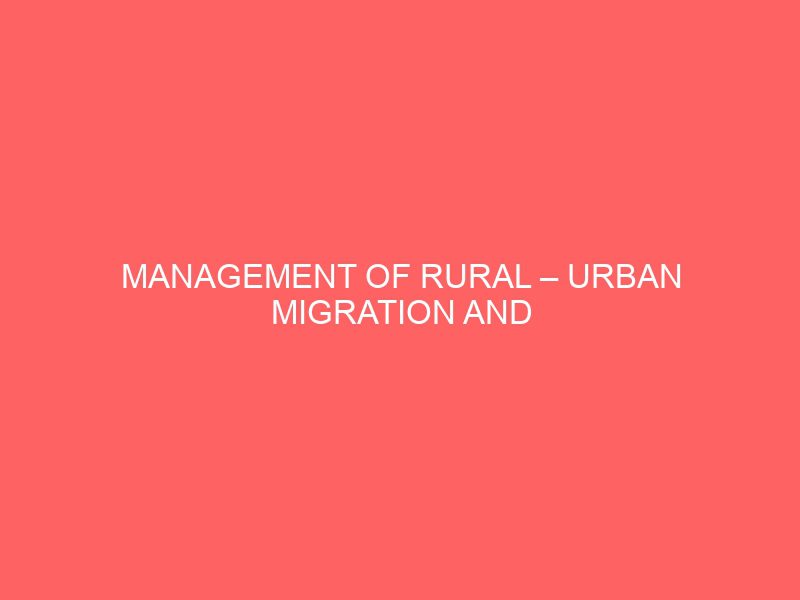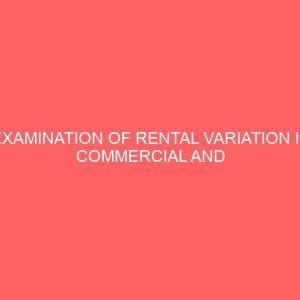Description
CHAPTER ONE
INTRODUTION
1.1 BACKGROUND TO THE STUDY
This research is on Management of rural – urban migration and economic development in Nigeria: the case of Anambra state (2004 – 2010). The burden of rural-urban migration in Anambra State is multifaceted and intertwining. As such, an analysis of one decompose component or consequence, such as unbearable population density, impinges on other issues within the identifiable cycle of burdens. For instance, in examining the management of rural- urban migration and its effect on economic development, has it result to increase in population in the urban areas while the rural areas lack development or at the extreme its explosion. Various other subsequent effects are expected to be considered.
Population explosion activates the housing challenge both at micro (family) and macro (society) levels. Congestion in households and communities has implications for both the health and psychology of victims. Nigerian cities such as Lagos, Port-Harcourt, Kano, and Onitsha among others are characterized by human traffic, vehicular congestions, environmental pollution, consistent in-migration and spurious expansion of territories to accommodate human additions.
Nigeria is a country with over 150,000,000 million people (Censes 2006) and the giant of Africa. Most international organizations and foreign investors find a good market in Nigeria. The oil-boom in the 1970s has deeply affected the economic development of the country and continues to do so as government focuses on oil sector and neglects the agricultural sector which was the prime of the economy and economic development before the oil-boom. Government insensitivity to the plight of the rural communities whose major source of livelihood is agriculture has lead to migration of the rural dwellers to urban area for a good standard of living.
Nigeria, at independence in 1960, was largely a producer and net exporter of primary products. The six major agricultural products then were cocoa, rubber, palm oil, groundnut, cotton and palm kernel (Idode, 1989). Although there existed mining and quarrying activities, these were of negligible percentage and never counted for the economy as a whole (Olaloku, 1979). In other words, agricultural produce and raw materials constituted the main income for the country. Specifically, the Nigerian state as an exporter of agricultural goods had 69.4% of its total GDP for the year 1963/64 comprising the six aforementioned agricultural commodities (Olaloku, 1979:8).
Rural-Urban migration has led to uneven development of the country. The urban areas are over-populated while the rural areas are densely-populated, as young men and women leave the rural areas due to lack of infrastructures, social amenities, employment and economic development of the rural areas. According to Nyagba (2009), rural communities are the most important sectors of the Nigerian economy, indeed the West African regional population. There are several reasons to support this position.
Agriculture and rural development are crucial for the structural transformation and economic development of West Africa region. Agriculture contributes 20 per cent of GDP in northern Africa and 30 per cent of GDP in sub – Saharan Africa (Nyagba, 2009). The rural population represents an average of over 60 percent of the total population on the continent; about 90 per cent of the rural labor force engages directly or indirectly in agricultural activities. For the continent‟s rural people, accelerated agricultural and rural development would contribute to greater efficiency, increased household income, improved standards of living, and poverty reduction.
According to Onah (2010), agriculture had been the main foreign earnings in Nigeria before the advent of oil and accounted for major contribution to her GDP. Agriculture is a major source of employment for over 80% of Nigerians before oil dominated the economy. The poor technology, environmental hazards, high cost of implements due to neglect of agriculture has forced the rural farmer and young people in search of white collar jobs and high rate of rural-urban drift to survive. According to Peil (1981), people who migrate are mainly motivated by the desire to improve their standard of living above what is earlier obtained at home.
Migration is also caused by the desire of people to go to school and acquire knowledge to develop themselves and their environment Migration from the rural area to the urban area has become almost accepted as a normal phenomenon in Anambra state as many rural dwellers migrate to major urban areas in the state like Awka, Onitsha, Nnewi etc. as a result of economic development in these urban area. Most of the youths who want to enroll into tertiary institutions come to Awka, where federal universities, College of Education and other private universities are located. Those who want to engage in business and entrepreneurship find themselves in Onitsha. Onitsha is one of the largest commercial centers in West Africa, while others go to Nnewi to establish industries where household materials are produced and various auto parts are assembled. Therefore, most of the youth and adult men and women of working age (18-60) have left the rural area which has contributed negatively to economic development of Anambra state. The elderly men and women are left to provide for themselves with their little farm lands since most lands are used to build large mansions which nobody lives rather some people are paid to keep watch over their properties.
However, some of the migrants come back to these rural areas with experiences from the urban area, having made use of all forms of techniques to survive as a result of high competition in those urban areas. Some may set up patent medicine store, motor mechanics workshops, vulcanizing, hair salon, supermarket, restaurants, etc. while others may terrorize the rural dwellers, through robbery, kidnapping and criminal activities. Likewise the urban areas suffer from overpopulation, unemployment, crime, social vices, over utilization of infrastructure and poor management of social amenities. If the rural communities are able to develop the local technology, thereby give way for further development, it will attract government, international bodies, non government organizations and other agencies to support development of such area.
Policies and project such as rural electrification, self-help projects, DFRRI, ADP, NOA, ANIDS, NEEDS and SEEDS were some of the programmes setup by the federal, state or local government to manage the rural urban migration through some of these rural development policies or integrated rural development to see to its success. However management of rural-urban migration in the state seems to have some difficulty. In managing some of the programmes the state or local government, have put in place some agencies to address these problems and its adverse effects on economic development of the state. These agencies will be analyzed effectively to see how adequate they are in carrying out their duties.
Rural-urban migration has affected food production in the state. Most of the basic food stuffs are imported from the northern part of the country even t hough we have a better climate condition in the eastern region. The inadequate infrastructure and social amenities has also hampered development as most of the programmes and projects are located in the urban areas while the primary beneficiaries do not benefit from the project. In Nigeria most of the developmental plans are in favour of the urban areas. Business and commercial activities are successful where the market is. The rural areas do not have that market and factors of production are inadequate for economic development in Anambra state. It is on the strength of this situation and occurrences, that the researcher decided to study the”Management of Rural-Urban Migration and Economic Development, with emphasis on Anambra State.
1.2 STATEMENT OF THE PROBLEM
Over the years, there have been frequent outcries of increased rural-urban migration and the attendant adverse consequences. Rural-urban migration has left both the rural areas and urban areas affected negatively. It has been observed that the great pressure on economic infrastructure and accommodation facilities in terms of residential and office apartment has lead to high cost of rent in the urban areas.
The migrants are in the urban area for various reasons, either for education or business. Whichever vocation they seek, they are faced with competition. This has lead to frustration and psychological problems due to non-accomplishment of goals and objectives of migrating to the urban area. The state government has set up agencies and put in place programmes to address this issue. Most of the agencies responsible for management of the rural-urban migration are cited in the urban centers. Such as ASCOL, ADP, SEED, IFAD, Ministry of Rural Development and many more, they seem to forget the reason behind their establishment; likewise the personnel recruited into these agencies seem to be unwilling to enter the field to gather information that will assist them in executing these projects in the rural areas while creating other policies or programmes that will reduce inflow to the urban areas that are already overpopulated.
The state government however, in implementation process engages in politics, as they swerve resources for economic development to inconsequential areas, while neglecting other areas like the agricultural sector. Less focus on agricultural sector will bring about food scarcity and low agricultural produce for a teeming population. The fall in food production will result to food insecurity and importation. The lands to be used for agriculture or mechanized farming have been used to build hotels, accommodations, industries and mansions.
Furthermore, as attention is being directed to the urban area, major projects and programmes that ought to be directed to the rural areas are diverted to t he urban area. Yet these facilities in the urban areas are not properly maintained by some of these agencies. The primary beneficiaries do not gain or participate in such projects. Hence the rural areas languish in abject poverty, low life expectancy rate, unemployment, lack of social amenities, poor power generation and basic infrastructures which hamper economic development. Likewise some migrants could be faced with socio-psychological vacuum since most have detached themselves from their home and the altruistic feeling of their home is no longer theirs.
Against this backdrop, the questions that agitate the mind of the researcher are;
(i) To what extent has housing scheme helped in tackling the challenges of rural-urban migration in Anambra State?
(ii) What effort has been made by the power sector towards containing the pressure of rural-urban migration on the sector?
(iii) To what extent has the agricultural extension programme reduced rural- urban migration in Anambra State?
(iv) What are the impediments to the effective implementation of these programmes/measures?
(v) How has the management of rural-urban migration affected the economic development of Anambra state?
1.3 OBJECTIVES OF THE STUDY
The general objective of this study is to find out how government has been able to manage the migration of people from rural to urban areas in order to bring about the economic development of Anambra state.
The specific objectives of the study are to:
Investigate if the housing scheme has addressed the challenges of rural- urban migration
Examine the efforts made by the power sector towards containing the pressure of rural-urban migration on the economic development of Anambra state.
Investigate if the agricultural extension programme has reduced rural-urban migration in Anambra state.
Identify the factors that impede on the effective implementation of policy measures put in place to reduce rural-urban migration.
Examine the effect of economic development on management of rural-urban migration in Anambra state?
1.4 SIGNIFICANCE OF THE STUDY
This study is vital to knowledge because it addresses the extent in which government handles rural-urban migration policies and economic development of Anambra state. It will enable government to formulate policies that address the aspirations of both the rural and the urban dwellers. It will prompt government to review the management techniques of policies and programmes in the state to provide a better outcome. It will influence government to go back to agricultural sector to support oil sector, in order to improve the standard of living of the people and a more even development of the economy.
This study will also help in projects that will develop the rural areas and reduce rural-urban migration while stemming the tide of urban deficiencies. This could be achieved if beneficiaries of these programmes participate in issues and matters that affect them. They have a raw information and knowledge of their problems. This study is also significant for future researchers and will serve as a source of knowledge. Government can address and understand the issues of rural- urban migration as it affect the economic development and we must all understand that sustainable development is a strategy by which communities seek economic development approaches that also benefit the local environment and quality of life.
It can become an important guide to communities that have discovered that traditional approaches to planning and development are creating, rather than solving, societal and environmental problems.
1.6 SCOPE AND LIMITATIONS OF STUDY
The researcher will use data collected from three senatorial zones in Anambra State hence; Anambra South, Anambra Central and Anambra North. To analyze this work, the researcher will also limit the scope to the period between 2004- 2010.
In a research work like this, it is always difficult to complete the work without going through a number of limitations which may affect the accuracy of the work in terms of figures and facts given to the researcher in the course of the study. Likewise the impediments and bias nature posed by some of the respondents in a bid to protect their communities affect the validity of information. The books and journals used were quite sufficient though theories and authority seems not to have embraced some areas in rural-urban migration in climate change conditions “a world global phenomenon” of our times.








Reviews
There are no reviews yet.